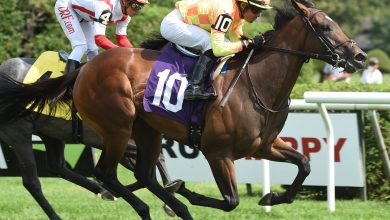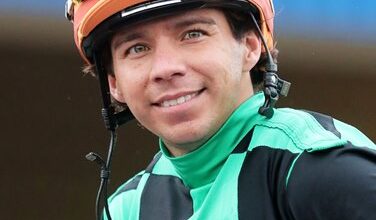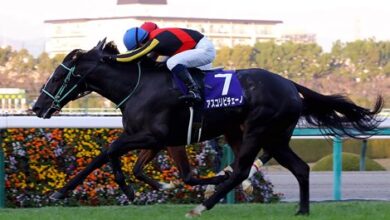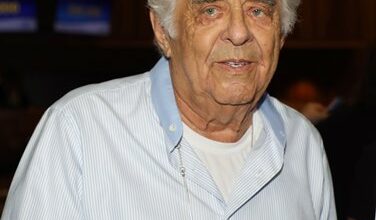Holliday Speaks on New Role, Future of New York Racing
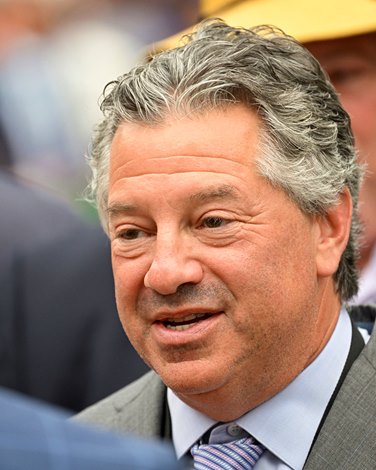
When Marc Holliday was presented with the opportunity to become chairman of the board for the New York Racing Association late in 2021, he knew in his heart what he needed to do.
“I love racing. I love the equine industry, and I love New York,” said Holliday, a NYRA board member since 2014 who was appointed chairman in December. “I’d say those are the big three reasons why I took the job. The sport really does so much for so many people, and I don’t think everyone appreciates just how important the equine industry is to New York State, be it upstate or downstate.”
The 53-year-old Holliday brings to the position the kind of racing and business experience that is vital for NYRA as it faces a crucial period that features the redevelopment of Belmont Park while dealing with day-to-day issues such as the high cost of racing in New York and the specter of challenges for wagering dollars from sports betting.
One of New York’s top business leaders, Holliday is the chairman and CEO of SL Green Realty Corporation, New York City’s largest commercial landlord. He joined the company in 1998, becoming CEO in 2004 and adding the additional responsibilities as chairman in 2019 while leading the development of a core business strategy for a company with more than 110 assets in the tri-state New York area covering approximately 50 million square feet.
A longtime fan of horse racing, the Long Island native has raced under the banner of Blue Devil Racing since 2007 and owned the grade 1-winning filly sprinter Come Dancing , who won nine of 19 starts for trainer Carlos Martin from 2016-20 and earned $1,216,783. His New York-based stable has posted 131 wins since its inception, with earnings of $6,355,862.
“I was thrilled to be a part of the board for the years leading up to (chairman) Mike Del Giudice stepping down at the end of 2021, and it gave me an opportunity to step up and help out an organization that employs a diverse group of workers and supports upstate farms and enables people to connect with animals, the jockeys, and racing in a very tangible way,” Holliday said. “I really want to do my part to help NYRA maintain and improve upon its market-leading position in Thoroughbred racing.”
In a question and answer interview after his first Belmont Stakes Presented by NYRA Bets (G1) as chairman, Holliday spoke with BloodHorse senior correspondent Bob Ehalt about his vision for NYRA while addressing a variety of topics of importance for New York racing and its fans.
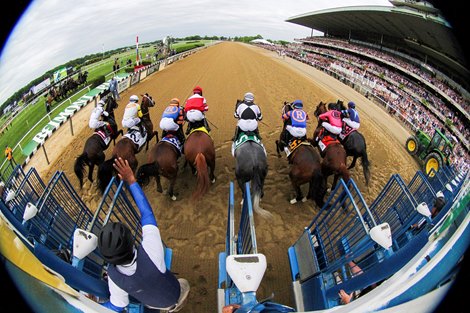
Racing at Belmont Park
BH: How will your experiences as an owner help you with your job as chairman?
MH: Being a longtime owner, breeder, and fan of the sport, it gives me a great perspective with which to work with my co-trustees and also with (NYRA CEO and president) David O’Rourke and his team to try and continuously improve the racing product, improve the fan experience, and hopefully improve the physical structures in which we put on our show. Most importantly, we want to improve a lot of the backstretch facilities which all the workers—who are hard workers working six, seven days a week—call home, whether it be here at Belmont or at Saratoga. We want these people to have a great working experience as much as we want fans to have a great entertainment experience.
BH: With your experience as an owner you know the financial strains of running a stable in New York. What can be done to help owners and trainers and make it more economically feasible for them?
MH: The number one thing we have to do, working hand-in-hand with the State and the Gaming Commission, is to figure out ways to reduce the cost of doing business here in New York State for the horsemen. It’s very expensive, with labor being far and away the number one cause here in New York, and it goes from there to workman’s compensation and all the other expenses of stabling and getting good people to care for these horses. In other jurisdictions the costs are much less, but here in New York we have a very high cost structure, and I think we need ways to get more money to be able to support the horsemen and to support the workers and to try and come up with incentives for horseman so they will want to run here. We also need incentives for people to bring their stables here so we’re at full capacity throughout the year. In order to do that, we’ve got to make it economically achievable, not just for the top owners and trainers but for all the trainers and owners that are committed to running in New York 365 days a year.
BH: Is there anything in particular that can be done to help the situation?
MH: (President) Joe Appelbaum and (the New York Thoroughbred Horsemen’s Association) and NYRA have worked together on self-retention risk programs that have greatly reduced liability insurance and workman’s comp insurance for the horsemen. I think that’s step one. Step two for us, (owner and board of trustees member) Mike Dubb spearheads physical assets at the board level for NYRA and working with (NYRA senior vice president of operations and capital projects) Glen Kozak, who is one of the premier trackmen in the country, they have created brand-new dormitories and facilities that we don’t charge for. That makes New York so unique in the world of racing that we provide housing for transient workers, and it’s not just housing, but new and improved housing, to help defray housing costs. The last piece of it is really working with the state on making the visas as accessible as possible so we can get to that population of workers that are skilled and adept at working with horses and want to work with those horses early in the morning till late in the evening without having a crippling cost of compensation associated with it while paying a fair living wage to everybody that works here.
BH: How will your business experience help NYRA?
MH: I’m a developer and we have a lot of good business people on the board and we have a lot of good business people running NYRA. Renee Postel is our CFO and she does a tremendous job on budget forecasting and producing the books. NYRA has returned to health and fiscal responsibility under this management team and under this board in the eight or so years since the reorganization. We’re very proud of that financial track record, and I’m happy to lend my expertise in that area to NYRA. But the area I can probably make the most impact would be in the long-term redevelopment of Belmont racetrack. Belmont Park is a great track and a great facility, but it’s definitely in need of substantial capital improvements and in some cases wholesale new development. I’ve made it my primary goal to transform Belmont from what it is today, not just into a modern facility, but into a world-class facility that would be as good as any domestically or internationally because that’s what New York racing deserves. We shouldn’t accept anything less. It’s hugely important for the future of Thoroughbred racing in New York State that we address this, and I think it will be transformational in terms of the kinds and amounts of people we can attract, accessing a younger base of fans. To do that, we have to really reimagine the property, unlock the infield and activate it, like so many other tracks do. Not just for big race days but also as a community asset that can be used when we’re not racing for sports fields and concerts and things of that ilk, which is a win-win for NYRA, the state, and local communities. A similar resource doesn’t exist in Floral Park, Elmont, the surrounding community, and we can and will work so that it has a dual purpose. What could be bad about that?
BH: I’m sure your past work as chairman of the equine safety committee will also figure prominently in your role as chairman.
MH: We have done an incredible amount of good for the equine athletes and for jockey safety with all the various track modifications we’ve made over the years. There has been a substantial investment to make the tracks safer and more forgiving and better for the horses. Another of our goals right up there with redeveloping Belmont Park is to develop a state-of-the-art new equine laboratory that would lead the country in terms of its ability to process effectively, efficiently, and competently all of the blood testing of horses to make sure that all of the medication compliance is being met and that results can be returned quickly and accurately. With technology being what it is, we are taking a hard look at that with the Gaming Commission and the State vet to see how we can bring something new to the table that is not just a good facility but a world-class facility.

A horse trains at Belmont Park
BH: What is the impact of the state legislature’s failure to put a $450 million bond for the Belmont Park redevelopment in the recently enacted state budget?
MH: I wouldn’t say it was a failure. In this case, the request was for a $450 million bond allocation and authorization to help us finance the total improvements of the track and the facility, and I think we can also work the equine blood lab into that equation. Unfortunately, so much of the focus in Albany got distracted during and after the budget process with so many of the other issues facing the state right now, whether it be affordable housing or gun violence. There was also a late focus on the abortion rights issue that detracted everybody from really digging in as much as we would have hoped into the benefits, facts, and circumstances around this wonderful development. Now we have the benefit of having an additional six months or so to make that case even more emphatically, though, to be honest, I think we did a really good job in the first place. We had support from all the local communities, all the local elected officials, and that’s what you typically want and what typically succeeds in Albany. But I think we have to go one step further and really emphasize what these benefits are going to be for the safety of the horses, safety for the jockeys, the fan experience, and the ability to pull in the Breeders’ Cup upon the completion of this great redevelopment, and, equally important, that we free up of Aqueduct Racetrack in a way that can unlock tremendous value for the state by not having the duplicity of racing operations encumbering two state-owned tracks.
BH: What do you like most about New York racing?
MH: I’ve grown up here and have been coming to the track and enjoying racing in New York since about 1978, when I got the racing bug. Then my father became a fairly significant owner racing on the New York circuit in the Standardbred sport and I remember going to The Meadowlands when they had 25,000 people and Yonkers Raceway and Roosevelt Raceway. It was very exciting for me back then. So when I had an opportunity as a lifelong New Yorker to get into the sport myself about 15-16 years ago, I wanted to do it in the sport of Thoroughbred racing because the animals are majestic. The sport is exhilarating to watch and participate in. Also as an owner, for me coming out to a place like Belmont or Saratoga on a beautiful day, whether it’s a spring day or a hot summer day, it’s about much more than the racing. It is a total experience of challenging yourself to try and handicap winners and looking at the competition on a world stage because we are the host of some of the greatest racing in the world. These are great athletes, and I feel like no one has the diversity of the experience that New York has.
BH: What are your thoughts on NYRA’s America’s Day at the Races telecasts on FOX Sports?
MH: We bring in the most money, which allows us to run the best races, and therefore we have the best broadcast product with America’s Day at the Races. In combination with FOX Sports, (NYRA chief revenue officer and president of NYRA Bets) Tony Allevato is really producing a wonderful product that can be enjoyed by diehard fans in the sport and a more general-interest participant as well. I really don’t think anyone does it so holistically as the way New York racing does it.
BH: Are you looking forward to your first Saratoga Race Course meet as chairman?
MH: Of course. It’s going to be extremely exciting. We’re running five days a week up there, and I think it’s clear that a five-day race week across a 40-day season is something that’s worked out phenomenally well. I know there were doubters initially, but we set all-time wagering records both in 2019 and 2021 while eclipsing a million in paid attendance every year. For a 40-day season, it’s a significant accomplishment. It demonstrates the excellence and importance of that summer meet, what it means to New York racing, and what it means to the city of Saratoga and upstate.
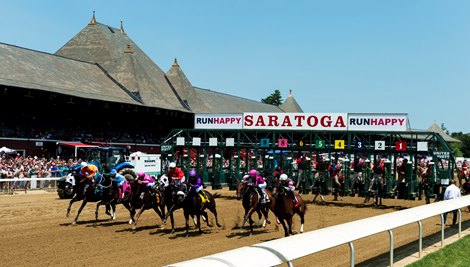
Horses leave the gate at Saratoga Race Course
BH: Aside from NYRA’s disciplinary hearings, what can be done to address those who frequently break the rules in the sport?
MH: I think the answer is twofold. First, NYRA has always, particularly of late, shown a determination in wanting to make sure this sport is an absolutely level playing field for the betting fans. We really owe them every effort we can to make sure that all of the trainers and vets are complying with these rigorous rules that have been put in place, and when the rules are broken we either can take up enforcement ourselves or work with the Gaming Commission which will enforce those rules. I think we do a good job with that, and as a result, we have a very reliable, clean product that we produce, and a lot of the things that get the headlines often are in other jurisdictions. Yet even when they’re in other jurisdictions, we take it seriously because it’s not just about infractions that may happen at our facilities, but it’s also about the reputation of this sport, and whether you’re here or you’re racing somewhere else, you always have to uphold that commitment and discipline. So I think we’ve done a good job with the manner in which we go about surveillance and detection and working with the state on enforcement and in some cases having our own hearings process when we feel certain matters have to be taken very seriously and immediately. Going forward we’ll be working under the umbrella of the (Horseracing Integrity and Safety Authority) so there will be a federal standard and a federal organization to try to take all the disparate rules and regulations and level of enforcement from these various tracks and bring it to a level of symmetry which we support completely.
BH: How do you feel HISA is going to impact New York racing and the sport in general?
MH: NYRA advocated for the Horseracing Integrity and Safety Act since Representative Paul Tonko first introduced legislation in 2015. So we’ve been there for the past seven years. HISA will achieve a national approach to medication control and it will establish the strongest anti-doping authority in the sport’s history and create uniform safety and integrity standards across the country. NYRA is confident HISA will modernize the sport in important ways in the near and long-term future. For someone like NYRA that already is adhering to some of the best rules and protocols, it should be relatively easy for us to comply with and show leadership. It will really become a function of cost. What are the incremental costs to achieving those goals? These goals don’t come for free, right? There’s going to be a cost and the industry is going to have to bear a fair amount of that cost along with the jurisdictions which host these racing venues. But as long as it can be done cost-effectively, I think it’ll be well worth whatever it takes to do it. It will probably be more of a culture change for some of the other tracks and venues that may have further to come in order to comply.
BH: With Kathy Hochul replacing Andrew Cuomo as governor of New York, have you seen any changes in the relationship between Albany and NYRA, and what do you look for going forward?
MH: I commend Governor Hochul and her outspoken support for the industry. Shortly after becoming governor last year, she came to Saratoga and enjoyed a day of racing and ultimately presented the trophy at the (2021 Runhappy Travers Stakes, G1). She was here with me and all of us at the Belmont Stakes and gave the call for riders up and presented the trophy to the winning connections of Mo Donegal . We haven’t had a governor in a long time that has shown that level of caring and understanding for the multi-billion dollar economic impact that equine racing brings to downstate and upstate and the essential role it plays in keeping farms and farm workers up and running and employed through these difficult times.

(L-R): Bobby Flay, Kathy Hochul, and Marc Holliday at Belmont Park
BH: What impact has the emergence of sports betting had on NYRA and what can it do to embrace the new wave of gamblers that is being created?
MH: David O’Rourke has really played a leading role here in envisioning early on the rise of sports betting and what the positive impacts would be as we codified and institutionalized this new form of entertainment, which is quite popular. Obviously, there’s a big need and desire out there for this form of entertainment. I think it’s being executed very responsibly, and while NYRA is not currently permitted to offer our product on those betting mobile platforms, the NYRA team led by David has aggressively pursued partnerships with BetMGM and Caesars that will allow us to enter that marketplace and develop new revenue streams. That’s really important for the future of NYRA and for the future of racing to become more integrated into this and not just looked at as a sport and form of betting entertainment that’s off to the side. It should be viewed as one that will soon have federal oversight through HISA, and hopefully it will be looked upon no differently than the NBA and MLB and NFL as a well-regulated sport on which people can wager for additional entertainment dollars in venues that are purposefully built and are best of class for a total entertainment experience. None of this would be possible without NYRA Bets, which continues to expand in terms of both membership and wagering handle, and the credit there certainly goes to Dave and Tony for the job they are doing. (NYRA Bets wagering has grown from $303 million in 2016 to $694.4 million in 2021, with active users growing by 255% over the same period.)
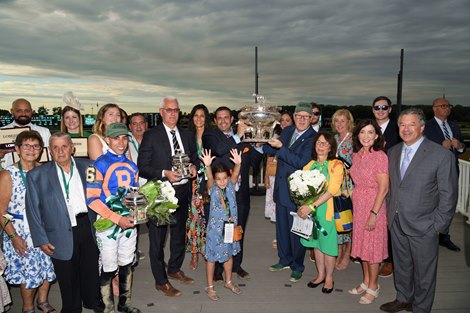
Marc Holliday (far right) joins in the trophy presentation to the connections of Mo Donegal for the Belmont Stakes
